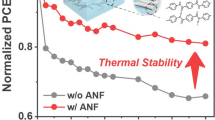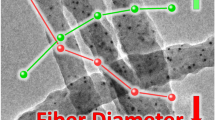Abstract
The structure of side chains of π-conjugated segments is a critical factor determining living crystallization-driven self-assembly (CDSA), a versatile platform to generate fiber-like nanostructures with precise length and composition. Herein, we design and synthesize three block copolymers (BCPs) containing same corona-forming poly(N-isopropyl acrylamide) (PNIPAM) segment, but different core-forming π-conjugated oligo(p-phenylene vinylene) (OPV) with linear pentyl (l-OPV), racemic 2-methyl butyl (r-OPV) and stereo-regular chiral (S)-2-methyl butyl (c-OPV) side chains, respectively. By using these BCPs of l-OPV-b-PNIPAM47, r-OPV-b-PNIPAM47 and c-OPV-b-PNIPAM47 as model, we aim to get a deep insight into how steric and stereo-regular effect induced by branched alkyl side chains of OPV segment affects the living CDSA. The results showed that l-OPV-b-PNIPAM47 exhibits typical characteristics of self-seeding and seeded growth of living CDSA to give uniform fiber-like micelles of controlled length. On the contrary, r-OPV-b-PNIPAM47 and c-OPV-b-PNIPAM47 with branched racemic and stereo-regular chiral alkyl side chains are more prone to self-nucleation during the micellar elongation to give short and polydisperse fiber-like micelles. The obvious self-nucleation during the micellar elongation of r-OPV-b-PNIPAM47 and c-OPV-b-PNIPAM47 is due to the increase of steric repulsion with OPV units induced by branched alkyl side chains, not the stereo-irregular effect of racemic alkyl side chains.
Similar content being viewed by others
References
Sun, X.; Zhu, Z.; **e, Z.; Liu, J.; Yin, J.; Yang, Y.; Jia, C.; Liu, F.; Yang, J. Self-assembly crystal, manipulated polymorphic crystalline structure and elevated thermal degradation temperature of poly(1,4-butylene adipate): effects of an aryl bisamide-based compound. Compos. Commun. 2021, 25, 100765.
Yuan, Z. Q.; Ding, A. S.; Xu, B. B.; Huang, X. Y.; Lu, G. L.; Guo, H. Double-bond-containing polyallene-based composite nanofibers. Compos. Commun. 2022, 32, 101189.
Cheng, A. H.; Zhang, C. Y; Deng, Z. C.; Sun, Y. L. Structure control of liquid crystalline block copolymers in liquid-phase self-assembly. Chin. J. Appl. Chem. 2021, 38, 1255–1267.
Zhang, Z. Y.; Li, Q.; Wang, D. L.; Fang, J. L.; Chen, D. Z. Controlled synthesis and photophysical properties of liquid crystalline diblock copolymers with side-chain discotic triphylene and calamitic azobenzene mesogens. Chin. J. Appl. Chem. 2021, 38, 1340–1352.
Zhang, L. F.; Eisenberg, A. Multiple morphologies of “crew-cut” aggregates of polystyrene-b-poly(acrylic acid) block copolymers. Science 1995, 268, 1728–1731.
Cai, W. B.; Liu, D. D.; Chen, Y.; Zhang, L.; Tan, J. B. Enzyme-assisted photoinitiated polymerization-induced self-assembly in continuous flow reactors with oxygen tolerance. Chinese J. Polym. Sci. 2021, 39, 1127–1137.
Bai, J. L.; Liu, D.; Wang, R. Self-assembly of amphiphilic diblock copolymers induced by liquid-liquid phase separation. Chinese J. Polym. Sci. 2021, 39, 1217–1224.
Xu, Z.; Li, W. Control the self-assembly of block copolymers by tailoring the packing frustration. Chinese J. Chem. 2022, 40, 1083–1090.
Zhang, J.; Jiang, J.; Lin, S.; Cornel, E. J.; Li, C.; Du, J. Polymersomes: from macromolecular self-assembly to particle assembly. Chinese J. Chem. 2022, 40, 1842–1855.
Liu, Y.; Liu, B.; Nie, Z. Concurrent self-assembly of amphiphiles into nanoarchitectures with increasing complexity. Nano Today 2015, 10, 278–300.
Blanazs, A.; Armes, S. P.; Ryan, A. J. Self-assembled block copolymer aggregates: from micelles to vesicles and their biological applications. Macromol. Rapid Commun. 2009, 30, 267–277.
Kataoka, K.; Harada, A.; Nagasaki, Y. Block copolymer micelles for drug delivery: design, characterization and biological significance. Adv. Drug Deliv. Rev. 2001, 47, 113–131.
Jain, S.; Bates, F. S. Consequences of nonergodicity in aqueous binary PEO-PB micellar dispersions. Macromolecules 2004, 37, 1511–1523.
Bhargava, P.; Zheng, J. X.; Li, P.; Quirk, R. P.; Harris, F. W.; Cheng, S. Z. D. Self-assembled polystyrene-block-poly(ethylene oxide) micelle morphologies in solution. Macromolecules 2006, 39, 4880–4888.
Soo, P. L.; Eisenberg, A. Preparation of block copolymer vesicles in solution. J. Polym. Sci., Part B: Polym. Phys. 2004, 42, 923–938.
Battaglia, G.; Ryan, A. J. Effect of amphiphile size on the transformation from a lyotropic gel to a vesicular dispersion. Macromolecules 2006, 39, 798–805.
Zhang, J.; Chen, X. F.; Wei, H. B.; Wan, X. H. Tunable assembly of amphiphilic rod-coil block copolymers in solution. Chem. Soc. Rev. 2013, 42, 9127–9154.
van Rijn, P.; Tutus, M.; Kathrein, C.; Zhu, L. L.; Wessling, M.; Schwaneberg, U.; Boker, A. Challenges and advances in the field of self-assembled membranes. Chem. Soc. Rev. 2013, 42, 6578–6592.
Wang, H.; Lin, W. J.; Fritz, K. P.; Scholes, G. D.; Winnik, M. A.; Manners, I. Cylindrical block co-micelles with spatially selective functionalization by nanoparticles. J. Am. Chem. Soc. 2007, 129, 12924–12929.
Massey, J.; Power, K. N.; Manners, I.; Winnik, M. A. Self-assembly of a novel organometallic-inorganic block copolymer in solution and the solid state: nonintrusive observation of novel wormlike poly(ferrocenyldimethylsilane)-b-poly(dimethylsiloxane) micelles. J. Am. Chem. Soc. 1998, 120, 9533–9540.
Qian, J. S.; Guerin, G.; Lu, Y. J.; Cambridge, G.; Manners, I.; Winnik, M. A. Self-seeding in one dimension: an approach to control the length of fiberlike polyisoprene-polyferrocenylsilane block copolymer micelles. Angew. Chem. Int. Ed. 2011, 50, 1622–1625.
Wang, X.; Guerin, G.; Wang, H.; Wang, Y.; Manners, I.; Winnik, M. A. Cylindrical block copolymer micelles and co-micelles of controlled length and architecture. Science 2007, 317, 644.
Ma, J. Y.; Lu, G. L.; Huang, X. Y.; Feng, C. π-Conjugated-polymer-based nanofibers through living crystallization-driven self-assembly: preparation, properties and applications. Chem. Commun. 2021, 57, 13259–13274.
Cui, Y. N.; Wang, Z. Q.; Huang, X. Y.; Lu, G. L.; Manners, I.; Winnik, M. A.; Feng, C. How a small change of oligo(p-phenylenevinylene) chain length affects self-seeding of oligo(p-phenylenevinylene)-containing block copolymers. Macromolecules 2020, 53, 1831–1841.
Nie, J. C.; Wang, Z. Q.; Huang, X. Y.; Lu, G. L.; Feng, C. Uniform continuous and segmented nanofibers containing a π-conjugated oligo(p-phenylene ethynylene) core via “living” crystallization-driven self-assembly: importance of oligo(p-phenylene ethynylene) chain length. Macromolecules 2020, 53, 6299–6313.
Tao, D. L.; Lu, G. L.; Huang, X. Y.; Feng, C. Synthesis and crystallization- driven self-assembly of oligo(p-phenylenevinylene)-b-poly(ethylene glycol). J. Funct. Polym. 2019, 32, 617–625.
Nie, J. C.; Huang, X. Y.; Lu, G. L.; Winnik, M. A.; Feng, C. Living crystallization-driven self-assembly of linear and V-shaped oligo(p-phenylene ethynylene)-containing block copolymers: architecture effect of π-conjugated crystalline segment. Macromolecules 2022, 55, 7856–7868.
Kynaston, E. L.; Gould, O. E. C.; Gwyther, J.; Whittell, G. R.; Winnik, M. A.; Manners, I. Fiber-like micelles from the crystallization-driven self-assembly of poly(3-heptylselenophene)-block-polystyrene. Macromol. Chem. Phys. 2015, 216, 685–695.
Kynaston, E. L.; Nazemi, A.; MacFarlane, L. R.; Whittell, G. R.; Faul, C. F. J.; Manners, I. Uniform polyselenophene block copolymer fiberlike micelles and block co-micelles via living crystallization-driven self-assembly. Macromolecules 2018, 51, 1002–1010.
Han, L.; Wang, M.; Jia, X.; Chen, W.; Qian, H.; He, F. Uniform two-dimensional square assemblies from conjugated block copolymers driven by π−π interactions with controllable sizes. Nat. Commun. 2018, 9, 865.
Tao, D. L.; Feng, C.; Cui, Y. N.; Yang, X.; Manners, I.; Winnik, M. A.; Huang, X. Y. Monodisperse fiber-like micelles of controlled length and composition with an oligo(p-phenylenevinylene) core via “living” crystallization-driven self-assembly. J. Am. Chem. Soc. 2017, 139, 7136–7139.
Tao, D. L.; Feng, C.; Lu, Y. J.; Cui, Y. N.; Yang, X.; Manners, I.; Winnik, M. A.; Huang, X. Y. Self-seeding of block copolymers with a π-conjugated oligo(p-phenylenevinylene) segment: a versatile route toward monodisperse fiber-like nanostructures. Macromolecules 2018, 51, 2065–2075.
Ma, J. Y.; Ma, C.; Huang, X. Y.; de Araujo, P. H. H.; Goyal, A. K.; Lu, G. L.; Feng, C. Preparation and cellular uptake behaviors of uniform fiber-like micelles with length controllability and high colloidal stability in aqueous media. Fundam. Res. 2022. https://doi.org/10.1016/j.fmre.2022.01.020.
Qian, J. S.; Lu, Y. J.; Chia, A.; Zhang, M.; Rupar, P. A.; Gunari, N.; Walker, G. C.; Cambridge, G.; He, F.; Guerin, G.; Manners, I.; Winnik, M. A. Self-seeding in one dimension: a route to uniform fiber-like nanostructures from block copolymers with a crystallizable core-forming block. ACS Nano 2013, 7, 3754–3766.
Xu, J. J.; Ma, Y.; Hu, W. B.; Rehahn, M.; Reiter, G. Cloning polymer single crystals through self-seeding. Nat. Mater. 2009, 8, 348–353.
Shu, R.; Zha, L.; Eman, A. A.; Hu, W. B. Fibril crystal growth in diblock copolymer solutions studied by dynamic monte carlo simulations. J. Phys. Chem. B 2015, 119, 5926–5932.
Chen, J.; Zha, L.; Hu, W. Effect of solvent selectivity on crystallization-driven fibril growth kinetics of diblock copolymers. Polymer 2018, 138, 359–362.
Fukui, T.; Garcia-Hernandez, J. D.; MacFarlane, L. R.; Lei, S.; Whittell, G. R.; Manners, I. Seeded self-assembly of charge-terminated poly(3-hexylthiophene) amphiphiles based on the energy landscape. J. Am. Chem. Soc. 2020, 142, 15038–15048.
Acknowledgments
This work was financially supported by National Science Foundation for Distinguished Young Scholars (No. 51825304), the National Natural Science Foundation of China (Nos. 52122314, U22A20131, 51873229 and 51961145103), the Youth Innovation Promotion Association of CAS (No. Y2020062), Shanghai Scientific and Technological Innovation Project (Nos. 20JC1415400, 21520780100, 22JC1401000 and 22ZR1475400), Innovation Program of Shanghai Municipal Education Commission (No. 2019-01-07-00-05-E00012) and East China University of Science and Technology (No. SLD13223004). The authors thank Dr. Kun Cui for his assistance in TEM measurements and the beamline BL16B1 at SSRF for providing the beam time.
Author information
Authors and Affiliations
Corresponding authors
Additional information
Notes
The authors declare no competing financial interest.
Electronic Supplementary Information
10118_2023_2893_MOESM1_ESM.pdf
Living Crystallization-Driven Self-Assembly of Oligo(p-phenylene vinylene)-Containing Block Copolymers: Impact of Branched Structure of Alkyl Side Chain of π-Conjugated Segment
Rights and permissions
About this article
Cite this article
Song, Y., **ang, B., Huang, XY. et al. Living Crystallization-Driven Self-Assembly of Oligo(p-phenylene vinylene)-Containing Block Copolymers: Impact of Branched Structure of Alkyl Side Chain of π-Conjugated Segment. Chin J Polym Sci 41, 574–584 (2023). https://doi.org/10.1007/s10118-023-2893-7
Received:
Accepted:
Published:
Issue Date:
DOI: https://doi.org/10.1007/s10118-023-2893-7




